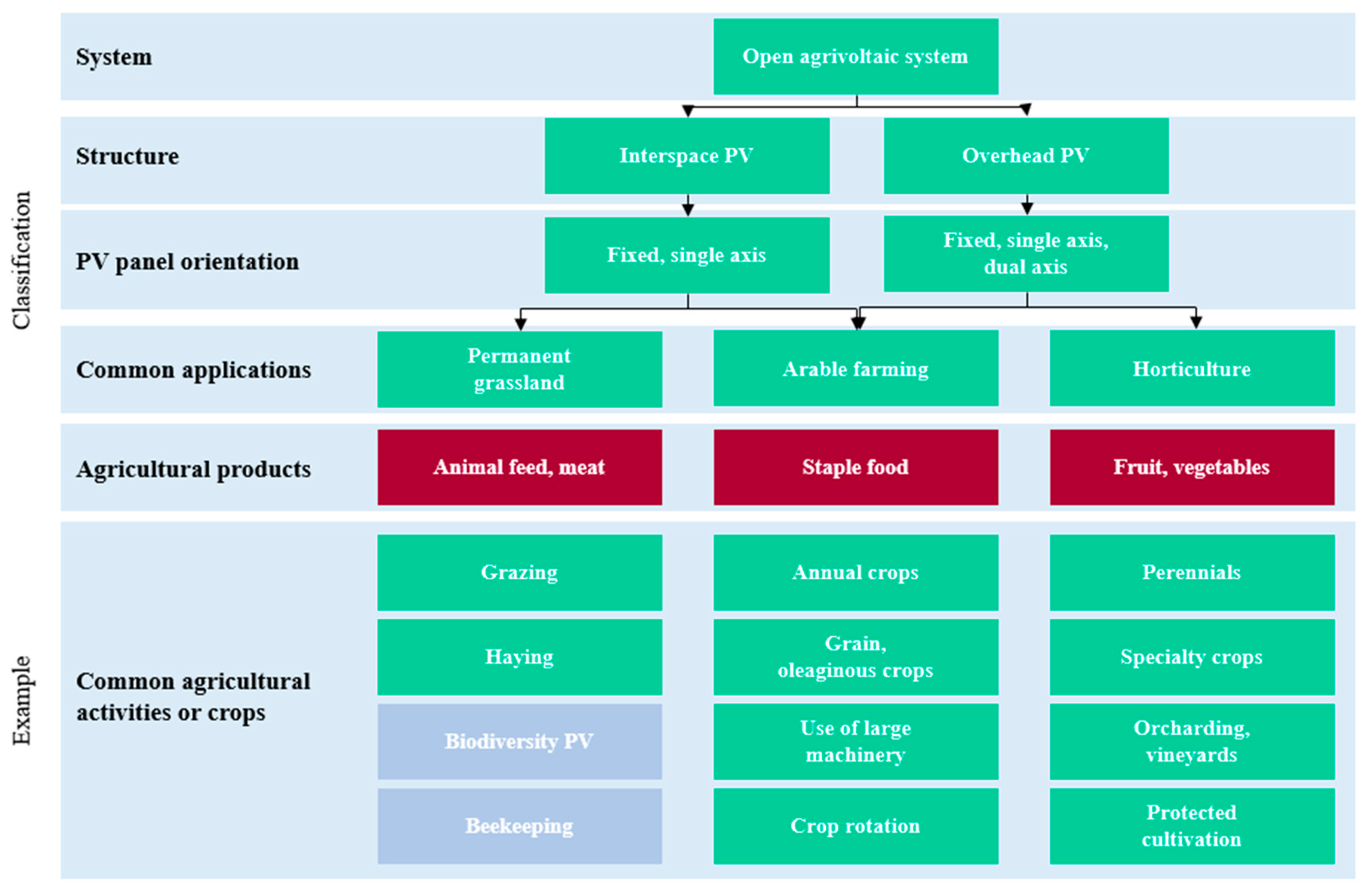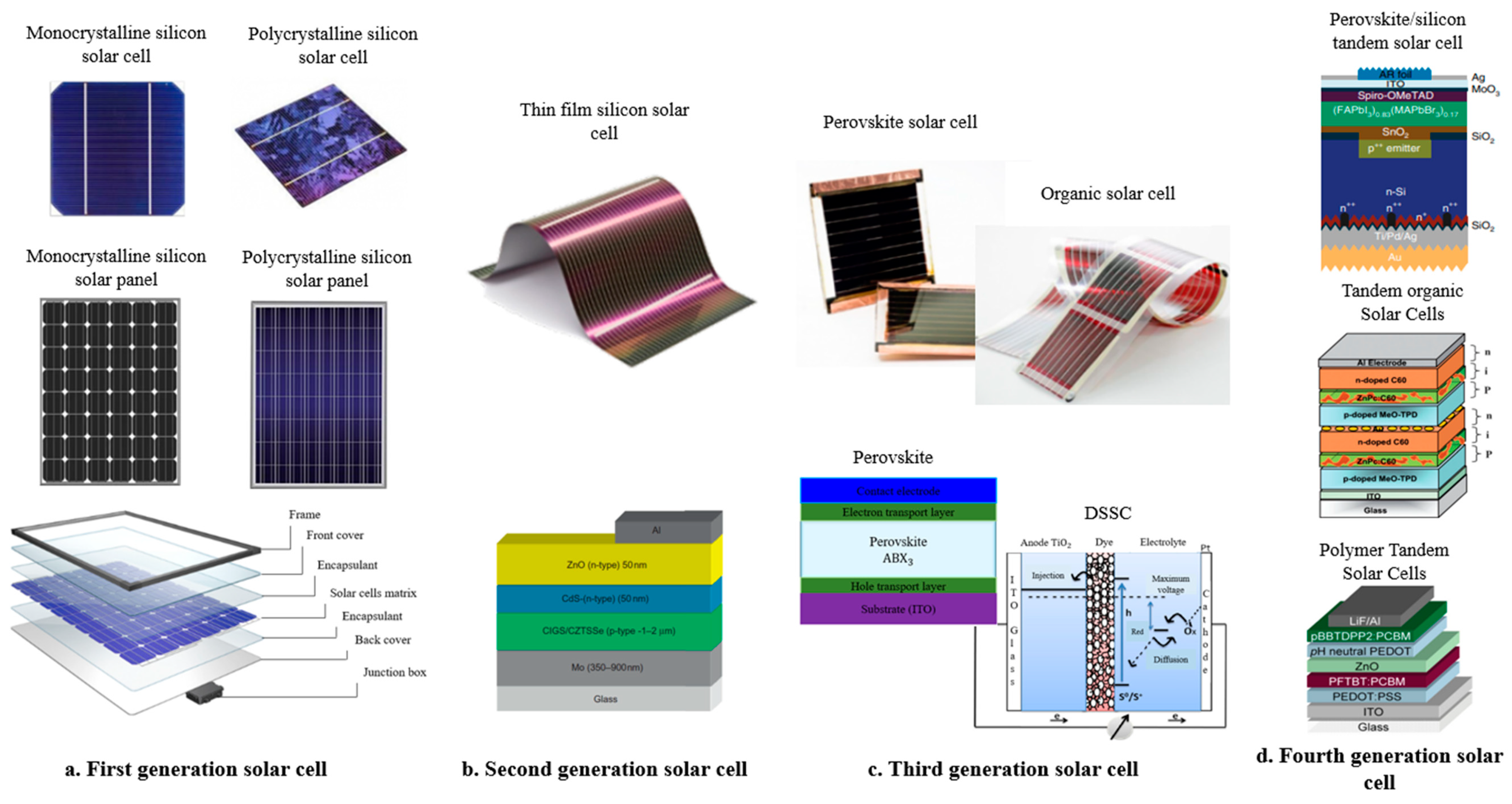Agrivoltaic, a Synergistic Co-Location of Agricultural and Energy Production in Perpetual Mutation: A Comprehensive Review
Abstract
1. Introduction
2. Definition and Terminology
3. Solar Panel Installation Techniques to Optimize Agrivoltaic Systems
3.1. Classification of the Different Agrivoltaic Installations
3.2. Installation Techniques to Optimize the Agrivoltaic System
3.2.1. Mounting Height or Overhead of Agrivoltaic Systems Installation
3.2.2. Vertically Mounted Agrivoltaic Systems
4. Factors Affecting the Operation of Photovoltaic Systems
5. Impact of Agrivoltaic Systems on Crops
5.1. Importance of Solar Radiation on the Process of Photosynthesis
5.2. Factors That Can Affect Crop Growth in Agrivoltaic Systems
5.3. Impact of Solar Panels on Crops
6. Influence of Agrivoltaics Systems on PV Module Performance
7. Models Already Developed in the Agrivoltaic Field
8. Conclusions
Author Contributions
Funding
Acknowledgments
Conflicts of Interest
Nomenclature
| β | Slope |
| γ | Azimuth |
| αs | Coordinates of solar altitude |
| γs | Solar azimuth |
| AC | Alternating current |
| Ai | Uncultivated agricultural area |
| An | Cultivated agricultural area |
| ATP | Adenosine triphosphate |
| CdTe | Cadmium telluride |
| DC | Direct current |
| DSSCs | Dye-sensitized solar cells |
| E | East |
| GECROS | Genotype-by-Environment interaction on CROp growth Simulator |
| h1 | Installation height greater than 2.1 m |
| h2 | Installation height less than 2.1 m |
| LER | Land Equivalence Ratio |
| N | North |
| NADPH | Nicotinamide adenine dinucleotide phosphate |
| PV | Photovoltaic |
| S | South |
| SAM | System Advisory Model |
| STICS | Simulateur mulTIdisciplinaire pour les Cultures Standard, or multidisciplinary simulator for standard crops |
| W | West |
| x | cultivated crop |
| y | electricity |
References
- Refaat, A.A.; Ismail, I.M. Water Food and Energy Sustainability Nexus. In Proceedings of the International Conference on Sustainable Futures–ICSF, Kingdom of Bahrain, 26–27 November 2017; Available online: https://wlv.openrepository.com/bitstream/handle/2436/621230/ASU-ICSF-2017-Proceedings.pdf?sequence=2&isAllowed=n#page=280 (accessed on 13 March 2023).
- FAO. The Water-Energy-Food Nexus: A new approach in support of food security and sustainable agriculture. In Rome The Food and Agricultural Organisation of the United Nations; FAO: Rome, Italy, 2014. [Google Scholar]
- Carmona-Moreno, C.; Crestaz, E.; Cimmarrusti, Y.; Farinosi, F.; Biedler, M.; Amani, A.; Mishra, A.; Carmona-Gutierrez, A. Implementing the Water–Energy–Food–Ecosystems Nexus and Achieving the Sustainable Development Goals; UNESCO, European Union, IWA Publishing: Rome, Italy, 2021. [Google Scholar]
- OCDE/FAO. Perspectives Agricoles de l’OCDE et de la FAO 2019-2028. 2019; OECD and Food and Agriculture Organization of the United Nations: Rome, Italy, 2019. [Google Scholar] [CrossRef]
- Nations Unis. La population Mondiale Atteindra 8 Milliards le 15 Novembre 2022; Nations Unis: New York, NY, USA, 2022. [Google Scholar]
- FAO. Produire Plus Avec Moins: Guide A L’intention Des Décideurs Sur L’intensification Durable De L’agriculture Paysanne; FAO: Rome, Italy, 2011. [Google Scholar]
- GIZ. Qu’est-ce Que L’agriculture Durable? GIZ: Bonn et Eschborn, Germany, 2016. [Google Scholar]
- Wise, T.A. Global Development And Environment Institute Document De Travail NO. 13-04: Pourra-t-on Nourrir la Planète en 2050? Un Etat des lieux des Modèles de Prévisions actuels; Global Development and Environment Institute (GDAE): Medford, MA, USA, 2013. [Google Scholar]
- Sass, J.; Hahn, A. Solar Powered Irrigation Systems (SPIS): Technology; Economy; Impacts. Deutsche Gesellschaft für Internationale Zusammenarbeit (GIZ) GmbH: Bonn, Germany, 2020. [Google Scholar]
- dos Santos Isaías, D.H.; Cuamba, B.C.; Leão, A.J. A Review on Renewable Energy Systems for Irrigation in Arid and Semi-Arid Regions. J. Power Energy Eng. 2019, 7, 21–58. [Google Scholar] [CrossRef]
- Kumar, A.; Kumar, M. Solar energy in irrigation. J. Indian Water Resour. 2017, 37, 2. [Google Scholar]
- Belaud, G.; Mateos, L.; Aliod, R.; Buisson, M.C.; Faci, E.; Gendre, S.; Ghinassi, G.; Gonzales Perea, R.; Lejars, C.; Maruejols, F.; et al. Irrigation and energy: Issues and challenges. Irrig. Drain. 2019, 69, 177–185. [Google Scholar] [CrossRef]
- Picazo, M.A.P.; Juárez, J.M.; García-Márquez, D. Energy Consumption Optimization in Irrigation Networks Supplied by a Standalone Direct Pumping Photovoltaic System. Sustainability 2018, 10, 4203. [Google Scholar] [CrossRef]
- Nederstigt, J.; Bom, G.J. Renewable Energy For Smallholder Irrigation: A Desk Study On The Current State And Future Potential Of Using Renewable Energy Sources For Irrigation By Smallholder Farmers; SNV Corporate Office Renewable Energy: Ouagadougou, Burkina Faso, 2014. [Google Scholar]
- IRENA. Le Commerce Et L’avenir De L’énergie Solaire: Pour Des Marchés Du Solaire Photovoltaïque Fondés Sur L’ouverture Et La Qualité; Organisation mondiale Du Commerce Et Agence Internationale Pour Les Energies Renouvelables: Suisse, France, 2021. [Google Scholar]
- Al-Khazzar, A. The Required Land Area for Installing a Photovoltaic Power Plant. Iran. J. Energy Environ. 2017, 8, 11–17. [Google Scholar]
- Oleskewicz, K. The Effect of Gap Spacing Between Solar Panel Clusters on Crop Biomass Yields, Nutrients, and the Microenvironment in a Dual-Use Agrivoltaic System. Master’s Thesis, University of Massachusetts Amherst, Amherst, MA, USA, 2020. [Google Scholar]
- Nakata, H.; Ogata, S. Integrating Agrivoltaic Systems into Local Industries: A Case Study and Economic Analysis of Rural Japan. Agronomy 2023, 13, 513. [Google Scholar] [CrossRef]
- Wagner, M.; Lask, J.; Kiesel, A.; Lewandowski, I.; Weselek, A.; Högy, P.; Trommsdorff, M.; Schnaiker, M.-A.; Bauerle, A. Agrivoltaics: The Environmental Impacts of Combining Food Crop Cultivation and Solar Energy Generation. Agronomy 2023, 13, 299. [Google Scholar] [CrossRef]
- Jamil, U.; Bonnington, A.; Pearce, J.M. The Agrivoltaic Potential of Canada. Sustainability 2023, 15, 3228. [Google Scholar] [CrossRef]
- Armstrong, A.; Ostle, N.J.; Whitaker, J. Solar park microclimate and vegetation management effects on grassland carbon cycling. Environ. Res. Lett. 2016, 11, 074016. [Google Scholar] [CrossRef]
- Hernandez, R.R.; Easter, S.B.; Murphy-Mariscal, M.L.; Maestre, F.T.; Tavassoli, M.; Allen, E.B.; Barrows, C.W.; Belnap, J.; Ochoa-Hueso, R.; Ravi, S.; et al. Environmental impacts of utility-scale solar energy. Renew. Sustain. Energy Rev. 2014, 29, 766–779. [Google Scholar] [CrossRef]
- Goetzberger, A.; Zastrow, A. On the Coexistence of Solar- Energy Conversion and Plant Cultivation. Int. J. Sol. Energy 1982, 1, 55–69. [Google Scholar] [CrossRef]
- Dupraz, P.; Marrou, H.; Talbot, G.; Dufour, L.; Nogier, A.; Ferard, Y. Combining solar photovoltaic panels and food crops for optimising land use: Towards new agrivoltaic schemes. Renew. Energy 2011, 36, 2725–2732. [Google Scholar] [CrossRef]
- Marrou, H.; Guilioni, H.; Dufour, L.; Dupraz, C.; Wery, J. Microclimate under agrivoltaic systems: Is crop growth rate affected in the partial shade of solar panels? Agric. For. Meteorol. 2013, 177, 117–132. [Google Scholar] [CrossRef]
- Campana, P.E.; Stridh, B.; Amaducci, S.; Colauzzi, M. Optimisation of vertically mounted agrivoltaic systems. J. Clean. Prod. 2021, 325, 129091. [Google Scholar] [CrossRef]
- Kim, S.; Kim, Y.; On, Y.; So, J.; Yoon, C.; Kim, S. Hybrid Performance Modeling of an Agrophotovoltaic System in South Korea. Energies 2022, 15, 6512. [Google Scholar] [CrossRef]
- Thompson, E.P.; Bombelli, E.L.; Shubham, S.; Watson, H.; Everard, A.; D’Ardes, A.; Schievano, A.; Bocchi, S.; Zand, N.; Howe, C.J.; et al. Tinted Semi-Transparent Solar Panels Allow Concurrent Production of Crops and Electricity on the Same Cropland. Adv. Energy Mater. 2020, 10, 2001189. [Google Scholar] [CrossRef]
- Macknick, J.; Hartmann, H.; Barron-Gafford, G.; Beatty, B.; Burton, R.; Choi, C.S.; Matthew, D.; Davis, R.; Figueroa, J.; Garrett, A.; et al. The 5 Cs of Agrivoltaic Success Factors in the United States: Lessons From the InSPIRE Research Study; National Renewable Energy Laboratory: Golden, CO, USA, 2022; NREL/TP-6A20-83566. Available online: https://www.nrel.gov/docs/fy22osti/83566.pdf (accessed on 3 November 2022).
- Hernandez, R.R.; Armstrong, A.; Burney, J.; Ryan, G.; Moore-O’Leary, K.; Diédhiou, I.; Grodsky, S.M.; Saul-Gershenz, L.; Davis, R.; Macknick, J.; et al. Techno–ecological synergies of solar energy for global sustainability. Nat. Sustain. 2019, 2, 560–568. [Google Scholar] [CrossRef]
- Weselek, A.; Ehmann, A.; Zikeli, S.; Lewandowski, I.; Schindele, S.; Högy, P. Agrophotovoltaic systems: Applications, challenges, and opportunities. A review. Agron. Sustain. Dev. 2019, 39, 35. [Google Scholar] [CrossRef]
- Schindele, S.; Trommsdorff, M.; Schlaak, A.; Obergfell, T.; Bopp, G.; Reise, C.; Braun, C.; Weselek, A.; Bauerle, A.; Högy, P.; et al. Implementation of agrophotovoltaics: Techno-economic analysis of the price-performance ratio and its policy implications. Appl. Energ. 2020, 265, 114737. [Google Scholar] [CrossRef]
- Toledo, C.; Scognamiglio, A. Agrivoltaic Systems Design and Assessment: A Critical Review, and a Descriptive Model towards a Sustainable Landscape Vision (Three-Dimensional Agrivoltaic Patterns). Sustainability 2021, 13, 6871. [Google Scholar] [CrossRef]
- Chamara, R.; Beneragama, C. Agrivoltaic systems and its potential to optimize agricultural land use for energy production in Sri Lanka: A Review. J. Sol. Energy Res. (JSER) 2020, 5, 417–431. [Google Scholar]
- Al-Mamun, M.A.; Dargusch, P.; Wadley, D.; Zulkarnain, N.A.; Aziz, A.A. A review of research on agrivoltaic systems. Renew. Sustain. Energy Rev. 2022, 161, 112351. [Google Scholar] [CrossRef]
- Nonhebel, S. Renewable energy and food supply: Will there be enough land? Renew. Sustain. Energy Rev. 2005, 9, 191–201. [Google Scholar] [CrossRef]
- Majumdar, D.; Pasqualetti, M.J. Dual use of agricultural land: Introducing ‘agrivoltaics’ in Phoenix Metropolitan Statistical Area, USA. Landsc. Urban Plan. 2017, 170, 150–168. [Google Scholar] [CrossRef]
- Dinesh, H.; Pearce, J.M. The potential of agrivoltaic systems. Renew. Sustain. Energy Rev. 2016, 54, 299–308. [Google Scholar] [CrossRef]
- Abidin, M.A.Z.; Mahyuddin, M.N.; Zainuri, M.A.A.M. Solar Photovoltaic Architecture and Agronomic Management in Agrivoltaic System: A Review. Sustain. 2021, 13, 7846. [Google Scholar] [CrossRef]
- Elamri, Y.; Cheviron, B.; Lopez, J.M.; Dejean, C.; Belaud, G. Water budget and crop modelling for agrivoltaic systems: Application to irrigated lettuces. Agric. Water Manag. 2018, 208, 440–453. [Google Scholar] [CrossRef]
- Pascaris, A.S.; Schelly, C.; Pearce, J.M. A First Investigation of Agriculture Sector Perspectives on the Opportunities and Barriers for Agrivoltaics. Agronomy 2020, 10, 1885. [Google Scholar] [CrossRef]
- Lee, H.J.; Park, H.H.; Kim, Y.O.; Kuk, Y.I. Crop Cultivation Underneath Agro Photovoltaic Systems and Its Effects on Crop Growth, Yield, and Photosynthetic Efficiency. Agronomy 2022, 12, 1842. [Google Scholar] [CrossRef]
- Trommsdorff, M.; Kang, J.; Reise, C.; Schindele, S.; Bopp, G.; Ehmann, A.; Weselek, A.; Högy, P.; Obergfell, T. Combining food and energy production: Design of an agrivoltaic system applied in arable and vegetable farming in Germany. Renew. Sustain. Energy Rev. 2021, 140, 110694. [Google Scholar] [CrossRef]
- Trommsdorff, M.; Gruber, S.; Keinath, T.; Hopf, M.; Hermann, C.; Schönberger, F.; Zikeli, S.; Ehmann, A.; Weselek, A.; Bodmer, U.; et al. Agrivoltaics: Opportunities for Agriculture and the Energy Transition. Fraunhofer Institute for Solar Energy Systems ISE, 2nd ed.; Fraunhofer Institute for Solar Energy Systems ISE Heidenhofstrasse 2: Freiburg, Germany, 2022. [Google Scholar]
- Chae, S.; Kim, H.J.; Moon, H.; Kim, Y.H.; Ku, K. Agrivoltaic Systems Enhance Farmers’ Profits through Broccoli Visual Quality and Electricity Production without Dramatic Changes in Yield, Antioxidant Capacity, and Glucosinolates. Agronomy 2021, 12, 1415. [Google Scholar] [CrossRef]
- Macknick, J.; Beatty, B.; Hill, G. Overview of Opportunities for Co-Location of Solar Energy Technologies and Vegetation; NREL: Golden, CO, USA, 2013. [Google Scholar]
- Dawnbreaker. Agrivoltaics. 2022. Available online: https://science.osti.gov/-/media/sbir/pdf/Market-Research/SETO---Agrivoltaics-August-2022-Public.pdf (accessed on 26 December 2022).
- Kim, S.; Kim, S.; Yoon, C.Y. An Efficient Structure of an Agrophotovoltaic System in a Temperate Climate Region. Agronomy 2021, 11, 1584. [Google Scholar] [CrossRef]
- Marrou, H.; Wery, J.; Dufour, L.; Dupraz, C. Productivity and radiation use efficiency of lettuces grown in the partial shade of photovoltaic panels. Eur. J. Agron. 2013, 44, 54–66. [Google Scholar] [CrossRef]
- Marrou, H.; Dufour, L.; Wery, J. How does a shelter of solar panels influence water flows in a soil–crop system? Eur. J. Agron. 2013, 50, 38–51. [Google Scholar] [CrossRef]
- Valle, B.; Simonneau, T.; Sourd, F.; Pechier, P.; Hamard, P.; Frisson, T.; Ryckewaert, M.; Christophe, A. Increasing the total productivity of a land by combining mobile photovoltaic panels and food crops. Appl. Energy 2017, 206, 1495–1507. [Google Scholar] [CrossRef]
- Adeh, E.H.; Selker, J.S.; Higgins, C.W. Remarkable agrivoltaic influence on soil moisture, micrometeorology and water-use efficiency. PLoS ONE 2018, 13, e0203256. [Google Scholar] [CrossRef]
- Liu, Y.; Zhang, R.Q.; Huang, Z.; Cheng, Z.; López–Vicente, M.; Ma, X.; Wu, G. Solar photovoltaic panels significantly promote vegetation recovery by modifying the soil surface microhabitats in an arid sandy ecosystem. Land Degrad Dev. 2019, 30, 2177–2186. [Google Scholar] [CrossRef]
- Barron-Gafford, G.A.; Pavao-Zuckerman, M.A.; Minor, R.L.; Sutter, L.F.; Barnett-Moreno, I.; Blackett, D.T.; Thompson, M.; Dimond, K.; Gerlak, A.K.; Nabhan, G.P.; et al. Agrivoltaics provide mutual benefits across the food–energy–water nexus in drylands. Nat. Sustain. 2019, 2, 848–855. [Google Scholar] [CrossRef]
- Sekiyama, T.; Nagashima, A. Solar Sharing for Both Food and Clean Energy Production: Performance of Agrivoltaic Systems for Corn, A Typical Shade-Intolerant Crop. Environments 2019, 6, 65. [Google Scholar] [CrossRef]
- Cho, J.; Park, S.M.; Park, A.R.; Lee, O.C.; Nam, G.; Ra, I. Application of Photovoltaic Systems for Agriculture: A Study on the Relationship between Power Generation and Farming for the Improvement of Photovoltaic Applications in Agriculture. Energies 2020, 13, 4815. [Google Scholar] [CrossRef]
- Gonocruz, R.A.; Nakamura, R.; Yoshino, K.; Homma, M.; Doi, T.; Yoshida, Y.; Tani, A. Analysis of the Rice Yield under an Agrivoltaic System: A Case Study in Japan. Environments 2021, 8, 65. [Google Scholar] [CrossRef]
- Moreda, G.P.; Muñoz-García, M.A.; Alonso-García, M.C.; Hernández-Callejo, L. Techno-Economic Viability of Agro-Photovoltaic Irrigated Arable Lands in the EU-Med Region: A Case-Study in Southwestern Spain. Agronomy 2021, 11, 593. [Google Scholar] [CrossRef]
- Weselek, A.; Bauerle, A.; Zikeli, S.; Lewandowski, I.; Högy, P. Effects on Crop Development, Yields and Chemical Composition of Celeriac (Apium graveolens L. var. Rapaceum) Cultivated Underneath an Agrivoltaic System. Agronomy 2021, 11, 733. [Google Scholar] [CrossRef]
- Svanera, L.; Ghidesi, G.; Knoche, R. Agrovoltaico®: 10 Years Design and Operation Experience. In AIP Conference Proceedings; No. 1; AIP Publishing LLC: Long Island, NY, USA, 2020; Volume 2361. [Google Scholar] [CrossRef]
- Katsikogiannis, O.A.; Ziar, H.; Isabella, O. Integration of bifacial photovoltaics in agrivoltaic systems: A synergistic design approach. Appl. Energy 2022, 309, 118475. [Google Scholar] [CrossRef]
- Johansson, F.; Gustafsson, G.E.; Stridh, B.; Campana, P. 3D-thermal modelling of a bifacial agrivoltaic system: A photovoltaic module perspective. Energy Nexus 2022, 5, 100052. [Google Scholar] [CrossRef]
- Reagan, J.; Kurtz, S. Energetic Comparison of Vertical Bifacial to Tilted Monofacial Solar. IEEE J. Photovolt. 2022, 12, 1334–1340. [Google Scholar] [CrossRef]
- Luque, A.; Hegedus, S. Handbook of Photovoltaic Science and Engineering; John Wiley & Sons: Hoboken, NJ, USA, 2023. [Google Scholar]
- Lewis, N.S.; Crabtree, G.; Nozik, A.J.; Wasielewski, M.R.; Alivisatos, P. Basic Research Needs for Solar Energy Utilization. 2005. Available online: https://science.osti.gov/-/media/bes/pdf/reports/files/Basic_Research_Needs_for_Solar_Energy_Utilization_rpt.pdf (accessed on 24 November 2022).
- Khaligh, A.; Onar, O.C. Chapter 23—Energy Sources. In Power Electronics Handbook; Elsevier: Amsterdam, The Netherlands, 2018; pp. 725–765. [Google Scholar] [CrossRef]
- Gorjian, S.; Ebadi, H. Chapter 1—Introduction. In Photovoltaic Solar Energy Conversion; Elsevier: Amsterdam, The Netherlands, 2020. [Google Scholar] [CrossRef]
- FAO. The Use Of Solar Energy in Irrigated Agriculture: A Sourcebook For Irrigation Water Management With Alternative Energy Solutions; FAO: Rome, Italy, 2022. [Google Scholar] [CrossRef]
- Naamandadin, N.A.; Ming, C.J.; Mustafa, W.A. Relationship between Solar Irradiance and Power Generated by Photovoltaic Panel: Case Study at UniCITI Alam Campus, Padang Besar, Malaysia. J. Adv. Res. Eng. Knowl. 2018, 5, 16–20. [Google Scholar]
- Zhang, T.; Yang, H. Chapter 7—High Efficiency Plants and Building Integrated Renewable Energy Systems. In Handbook of Energy Efficiency in Buildings; Elsevier: Amsterdam, The Netherlands, 2019. [Google Scholar] [CrossRef]
- Blakers, A.; Zin, N.; McIntosh, K.R.; Fong, K. High Efficiency Silicon Solar Cells. Energy Procedia. 2013, 33, 1–10. [Google Scholar] [CrossRef]
- Eitner, U. Thermomechanics of Photovoltaic Modules. Master’s Thesis, Martin-Luther-Universität, Halle-Wittenberg, Germany, 2021. [Google Scholar]
- Simya, O.K.; Mahaboobbatcha, A.; Balachander, K.A. comparative study on the performance of Kesterite based thin film solar cells using SCAPS simulation program. Superlattices Microstruct. 2015, 82, 248–261. [Google Scholar] [CrossRef]
- Simya, O.K.; Radhakrishnan, P.; Ashok, A. Chapter 41- Engineered Nanomaterials for Energy Applications. Handb. Nanomater. Ind. Appl. 2018, 751–767. [Google Scholar] [CrossRef]
- Cheng, C.; Fan, H.J. Branched nanowires: Synthesis and energy applications. Nano Today 2012, 7, 327–343. [Google Scholar] [CrossRef]
- Zhang, T.; Wang, M.; Yang, H. A Review of the Energy Performance and Life-Cycle Assessment of Building-Integrated Photovoltaic (BIPV) Systems. Energies 2018, 11, 3157. [Google Scholar] [CrossRef]
- Rabanal-Arabach, J. Development of a c-Si Photovoltaic Module for Desert Climates. Ph.D. Thesis, Konstanz University, Konstanz, Germany, 2019. [Google Scholar]
- Li, W.; Zheng, J.; Hu, B.; Fu, H.; Hu, M.; Veyssal, A.; Zhao, Y.; He, J.; Liu, T.L.; Ho-Baillie, A.; et al. High-performance solar flow battery powered by a perovskite/silicon tandem solar cell. Nat. Mater. 2020, 19, 1326–1331. [Google Scholar] [CrossRef] [PubMed]
- Ameri, T.; Dennler, G.; Lungenschmied, C.; Brabec, C.J. Organic tandem solar cells: A review. Energy Environ. Sci. 2009, 2, 347–363. [Google Scholar] [CrossRef]
- Gilot, B.J.; Wienk, M.M.; Janssen, R.A.J. Optimizing Polymer Tandem Solar Cells. Adv. Energy Mater. 2010, 22, E67–E71. [Google Scholar] [CrossRef] [PubMed]
- Aroca-Delgado, R.; Pérez-Alonso, J.; Callejón-Ferre, A.J.; Velázquez-Martí, B. Compatibility between Crops and Solar Panels: An Overview from Shading Systems. Sustainability 2018, 10, 743. [Google Scholar] [CrossRef]
- Waller, R.; Kacira, M.; Magadley, E.; Teitel, M.; Yehia, I. Semi-Transparent Organic Photovoltaics Applied as Greenhouse Shade for Spring and Summer Tomato Production in Arid Climate. Agronomy 2021, 11, 1152. [Google Scholar] [CrossRef]
- Lubitz, D.W. Effect of manual tilt adjustments on incident irradiance on fixed and tracking solar panels. Appl. Energy 2011, 88, 1710–1719. [Google Scholar] [CrossRef]
- Yadav, A.K.; Chandel, S.S. Tilt angle optimization to maximize incident solar radiation: A review. Renew. Sustain. Energy Rev. 2013, 23, 503–513. [Google Scholar] [CrossRef]
- Božiková, M.; Bilcík, M.; Madola, V.; Szabóová, T.; Kubík, L.; Lendelová, J.; Cviklovic, C. The Effect of Azimuth and Tilt Angle Changes on the Energy Balance of Photovoltaic System Installed in the Southern Slovakia Region. Appl. Sci. 2021, 11, 8998. [Google Scholar] [CrossRef]
- Jafarkazemi, F.; Saadabadi, S.A. Optimum tilt angle and orientation of solar surfaces in Abu Dhabi, UAE. Renew. Energy 2013, 56, 44–49. [Google Scholar] [CrossRef]
- Brownson, J.R.S. Chapter 06-Sun-Earth Geometry. In Brownson JRS Solar Energy Conversion Systems; Academic Press: Boston, MA, USA, 2014; pp. 135–178. [Google Scholar] [CrossRef]
- Calabrò, E. An Algorithm to Determine the Optimum Tilt Angle of a Solar Panel from Global Horizontal Solar Radiation. J. Renew. Energy 2013, 2013, 307547. [Google Scholar] [CrossRef]
- Sado, K.A.; Hassan, L.H.; Sado, S. Photovoltaic panels tilt angle optimization. In Proceedings of the E3S Web of Conferences, Eskisehir, Turkey, 22–24 September 2021; Volume 239. [Google Scholar] [CrossRef]
- Mondol, J.D.; Yohanis, Y.G.; Norton, B. The impact of array inclination and orientation on the performance of a grid-connected photovoltaic system. Renew. Energy 2007, 32, 118–140. [Google Scholar] [CrossRef]
- Page, J. CHAPTER II-1-A-The Role of Solar-Radiation Climatology in the Design of Photovoltaic Systems. In Practical Handbook of Photovoltaics; Academic Press: Boston, MA, USA, 2012; pp. 601–670. [Google Scholar] [CrossRef]
- Ibrahim, M.H.; Ibrahim, M.A. The Optimum PV Panels Slope Angle for Standalone System: Case Study in Duhok, Iraq. In IOP Conference Series: Materials Science and Engineering; IOP Publishing: Bristol, UK, 2021; p. 012004. [Google Scholar] [CrossRef]
- Jacobson, M.Z.; Jadhav, V. World estimates of PV optimal tilt angles and ratios of sunlight incident upon tilted and tracked PV panels relative to horizontal panels. Solar Energy 2018, 169, 55–66. [Google Scholar] [CrossRef]
- Oudrane, A.; Zeghmati, B.; Chesneou, X.; Benaoumeurb, A. Modeling the radiate and energy balance of a building located in the adrar region. Recl. Mec. 2017, 1, 79–87. [Google Scholar]
- Nfaoui, M.; El-Hami, K. Extracting the maximum energy from solar panels. Energy Rep. 2018, 4, 536–545. [Google Scholar] [CrossRef]
- Yilmaz, S.; Ozcalik, H.R.; Dogmus, O.; Dincer, F.; Akgol, O.; Karaaslan, M. Design of two axes sun tracking controller with analytically solar radiation calculations. Renew. Sustain. Energy Rev. 2015, 43, 997–1005. [Google Scholar] [CrossRef]
- Chemisana, D.; Lamnatou, C. Photovoltaic-green roofs: An experimental evaluation of system performance. Appl. Energy 2014, 119, 246–256. [Google Scholar] [CrossRef]
- Ogaili, H.; Sailor, D.J. Measuring the Effect of Vegetated Roofs on the Performance of Photovoltaic Panels in a Combined System. J. Sol. Energy Eng. 2016, 138, 061009. [Google Scholar] [CrossRef]
- Alshayeb, M.J.; Chang, J.D. Variations of PV Panel Performance Installed over a Vegetated Roof and a Conventional Black Roof. Energies 2018, 11, 1110. [Google Scholar] [CrossRef]
- Osma-Pinto, G.; Ordóñez-Plata, G. Measuring factors influencing performance of rooftop PV panels in warm tropical climates. Sol. Energy 2019, 185, 112–123. [Google Scholar] [CrossRef]
- Swedan, N. Photosynthesis as a thermodynamic cycle. Heat Mass Transf. 2019, 56, 1649–1658. [Google Scholar] [CrossRef]
- Schmidt-Rohr, K. O2 and Other High-Energy Molecules in Photosynthesis: Why Plants Need Two Photosystems. Life 2021, 11, 1191. [Google Scholar] [CrossRef] [PubMed]
- Johnson, M.P. Photosynthesis. Essays Biochem. 2016, 60, 255–273. [Google Scholar] [CrossRef]
- Najafpour, M.M.; Pashaei, B. Photosynthesis: How and Why. In Advances in Photosynthesis–Fundamental Aspects; Intechopen: London, UK, 2012. [Google Scholar]
- Ceccarelli, E.A.; Arakaki, A.K.; Cortez, N.; Carrillo, N. Functional plasticity and catalytic efficiency in plant and bacterial ferredoxin-NADP(H) reductases. Biochim. et Biophys. Acta 2004, 1698, 155–165. [Google Scholar] [CrossRef] [PubMed]
- Yavari, N.; Tripathi, R.; Wu, B.S.; MacPherson, S.; Singh, J.; Lefsrud, M. The effect of light quality on plant physiology, photosynthetic, and stress response in Arabidopsis thaliana leaves. PLoS ONE. 2021, 16, e0247380. [Google Scholar] [CrossRef]
- Yu, K.; Feng, Z.; Du, H.; Wang, Q. Mechanics of photosynthesis assisted polymer strengthening. J. Mech. Phys. Solids 2021, 151, 104382. [Google Scholar] [CrossRef]
- Li, C.X.; Xu, Z.G.; Dong, R.Q.; Chang, S.X.; Wang, L.Z.; Khalil-Ur-Rehman, M.; Tao, J.M. An RNA Seq Analysis of Grape Plant lets Grown in vitro Reveals Different Responses to Blue, Green, Red LED Light, and White Fluorescent Light. PlantSci 2017, 8, 78. [Google Scholar] [CrossRef]
- Johkan, M.; Shoji, K.; Goto, F.; Hashida, S.; Yoshihara, T. Blue Light-emitting Diode Light Irradiation of Seedlings Improves Seedling Quality and Growth after Transplanting in Red Leaf Lettuce. Hortscience 2010, 45, 1809–1814. [Google Scholar] [CrossRef]
- Wang, Y.; Folta, K.M. Contributions of green light to plant growth and development. Am. J. Bot. 2013, 100, 70–78. [Google Scholar] [CrossRef]
- Alados, I.; Foyo-Moreno, I.; lados-Arboledas, L. Photosynthetically active radiation: Measurements and modelling. Agric. For. Meteorol. 1996, 78, 121–131. [Google Scholar] [CrossRef]
- Kalaji, H.M.; Jajoo, A.; Oukarroum, A.; Brestic, M.; Zivcak, M.; Samborska, I.A.; Cetner, M.D.; Łukasik, I.; Goltsev, V.; Ladle, R.J.; et al. Chapter 15—The Use of Chlorophyll Fluorescence Kinetics Analysis to Study the Performance of Photosynthetic Machinery in Plants. In Emerging Technologies and Management of Crop Stress Tolerance; Acadeemic Press: Cambridge, MA, USA, 2014. [Google Scholar] [CrossRef]
- Zhu, X.; Long, S.P.; Ort, D.R. What is the maximum efficiency with which photosynthesis can convert solar energy into biomass? Curr. Opin. Biotechnol. 2008, 19, 153–159. [Google Scholar] [CrossRef]
- Amthor, J.S. From sunlight to phytomass: On the potential efficiency of converting solar radiation to phyto-energy. New Phytol. 2010, 188, 939–959. [Google Scholar] [CrossRef]
- Othman, N.F.; Yaacob, M.E.; Su, A.S.M.; Jaafar, J.N.; Hizam, H.; Shahidan, M.F.; Jamaluddin, A.H.; Chen, G.; Jalaludin, A. Modeling of Stochastic Temperature and Heat Stress Directly Underneath Agrivoltaic Conditions with Orthosiphon Stamineus Crop Cultivation. Agronomy 2020, 12, 1472. [Google Scholar] [CrossRef]
- Cossu, M.; Yano, A.; Solinas, S.; Deligios, P.A.; Tiloca, M.T.; Cossu, A.; Ledda, L. Agricultural sustainability estimation of the European photovoltaic greenhouses. Eur. J. Agron. 2020, 118, 126074. [Google Scholar] [CrossRef]
- Qiao, X.; Sai, L.; Che, X.; Xue, L.; Lei, J. Impact of fruit-tree shade intensity on the growth, yield, and quality of intercropped wheat. PLoS ONE 2019, 14, e0203238. [Google Scholar] [CrossRef]
- Touil, S.; Richa, A.; Fizir, M.; Bingwa, B. Shading effect of photovoltaic panels on horticulture crops production: A mini review. Rev. Environ. Sci. Biotechnol. 2021, 20, 281–296. [Google Scholar] [CrossRef]
- AL-agele, H.A.; Proctor, K.; Murthy, G.; Higgins, C. A Case Study of Tomato (Solanum lycopersicon var. Legend) Production and Water Productivity in Agrivoltaic Systems. Sustainability 2021, 13, 2850. [Google Scholar] [CrossRef]
- Amaducci, S.; Yin, X.; Colauzzi, M. Agrivoltaic systems to optimise land use for electric energy production. Appl. Energy 2018, 220, 545–561. [Google Scholar] [CrossRef]
- Yue, S.; Guo, M.; Zou, P.; Wu, W.; Zhou, X. Effects of photovoltaic panels on soil temperature and moisture in desert areas. Environ. Sci. Pollut. Res. 2021, 28, 17506–17518. [Google Scholar] [CrossRef] [PubMed]
- Noor, N.F.; Reeza, A.A. Effects of solar photovoltaic installation on microclimate and soil properties in UiTM 50MWac Solar Park, Malaysia. In IOP Conference Series: Earth and Environmental Science; IOP Publishing: Bristol, UK, 2022; p. 012031. [Google Scholar] [CrossRef]
- Abu-Hamdeh, N.H. Thermal Properties of Soils as affected by Density and Water Content. Biosystems Eng. 2003, 86, 97–102. [Google Scholar] [CrossRef]
- Weinstock, D.; Appelbaum, J. Optimization of Solar Photovoltaic Fields. J. Sol. Energy Eng. 2009, 131, 031003. [Google Scholar] [CrossRef]
- Weselek, A.; Bauerle, A.; Hartung, J.; Zikeli, S.; Lewandowski, I.; Högy, P. Agrivoltaic system impacts on microclimate and yield of different crops within an organic crop rotation in a temperate climate. Agron. Sustain. Dev. 2021, 41. [Google Scholar] [CrossRef]
- Jo, H.; Asekova, S.; Bayat, M.A.; Ali, L.; Song, J.T.; Ha, Y.S.; Hong, D.H.; Lee, J.D. Comparison of Yield and Yield Components of Several Crops Grown under Agro-Photovoltaic System in Korea. Agriculture 2022, 12, 619. [Google Scholar] [CrossRef]
- Potenza, E.; Croci, M.; Colauzzi, M.; Amaducci, S. Agrivoltaic System and Modelling Simulation: A Case Study of Soybean (Glycine max L.) in Italy. Horticulture 2022, 8, 1160. [Google Scholar] [CrossRef]
- Kumpanalaisatit, M.; Setthapun, W.; Sintuya, H.; Pattiya, A.; Jansri, S.N. Current status of agrivoltaic systems and their benefits to energy, food, environment, economy, and society. Sustain. Prod. Consum. 2022, 33, 952–963. [Google Scholar] [CrossRef]
- Teng, J.W.C.; Soh, C.B.; Devihosur, S.C.; Tay, R.H.S.; Jusuf, S.K. Effects of Agrivoltaic Systems on the Surrounding Rooftop Microclimate. Sustainability 2022, 14, 7089. [Google Scholar] [CrossRef]
- Malu, P.R.; Sharma, U.S.; Pearce, J.M. Agrivoltaic potential on grape farms in India. Sustain. Energy Technol. Assess. 2017, 23, 104–110. [Google Scholar] [CrossRef]
- Pulido-Mancebo, J.S.; López-Luque, R.; Fernández-Ahumada, L.M.; Ramírez-Faz, J.C.; Gómez-Uceda, E.J.; Varo-Martínez, M. Spatial Distribution Model of Solar Radiation for Agrivoltaic Land Use in Fixed PV Plants. Agronomy 2022, 12, 2799. [Google Scholar] [CrossRef]

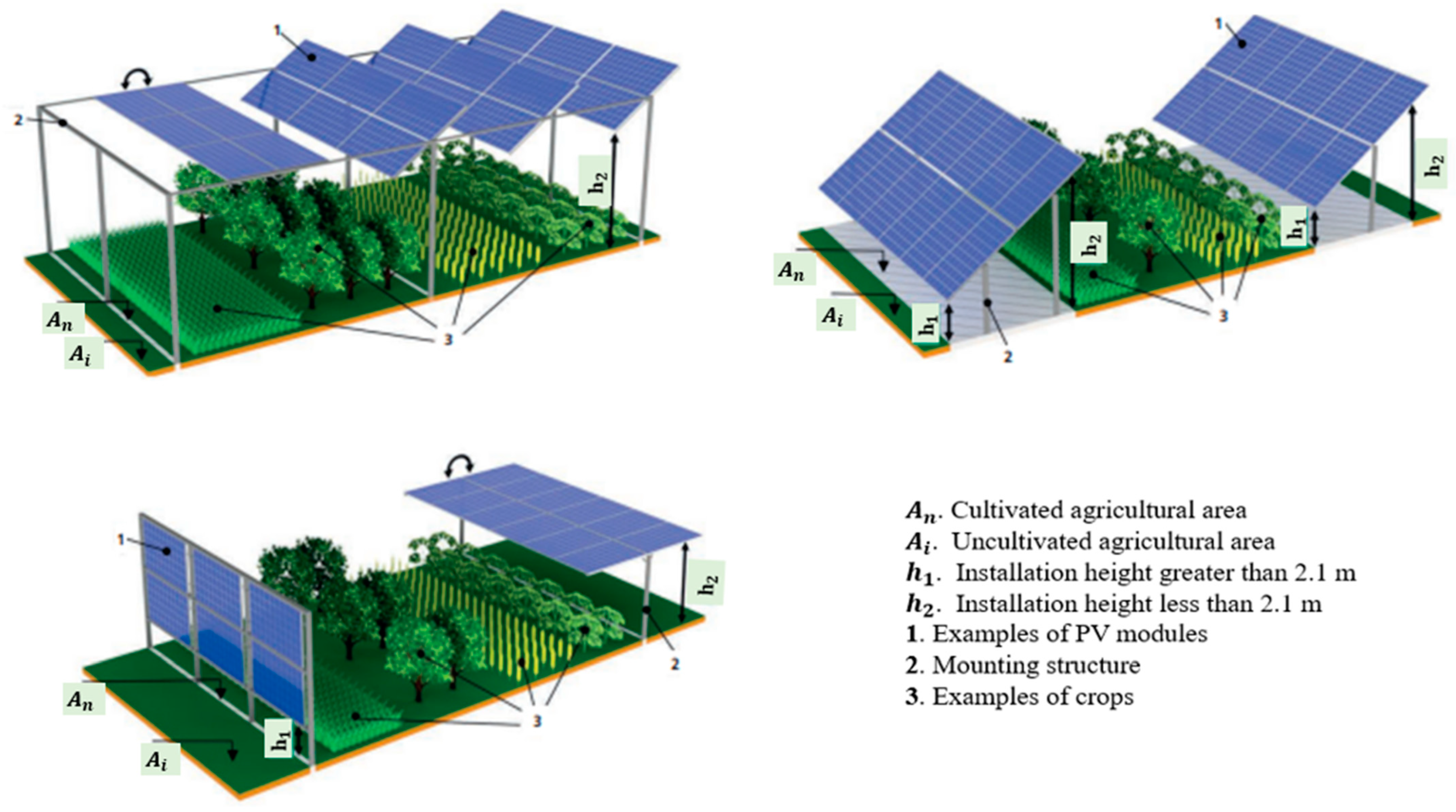
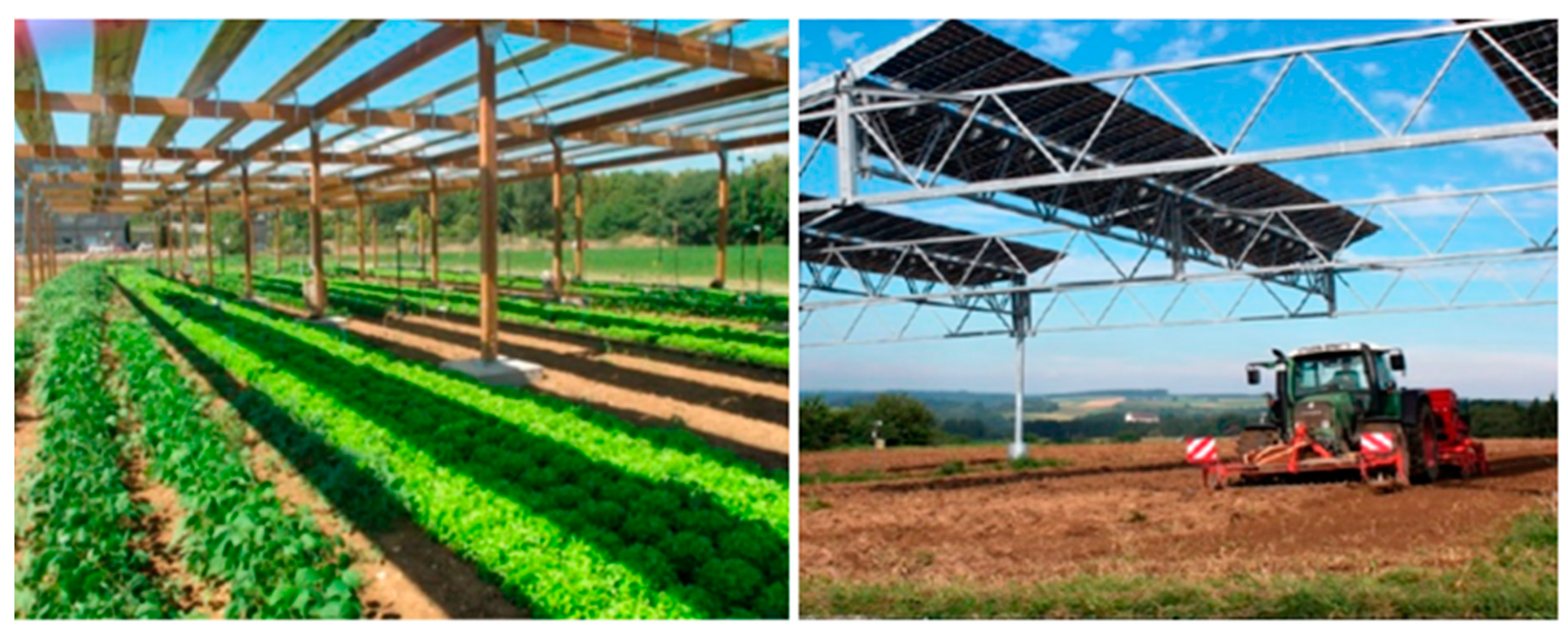
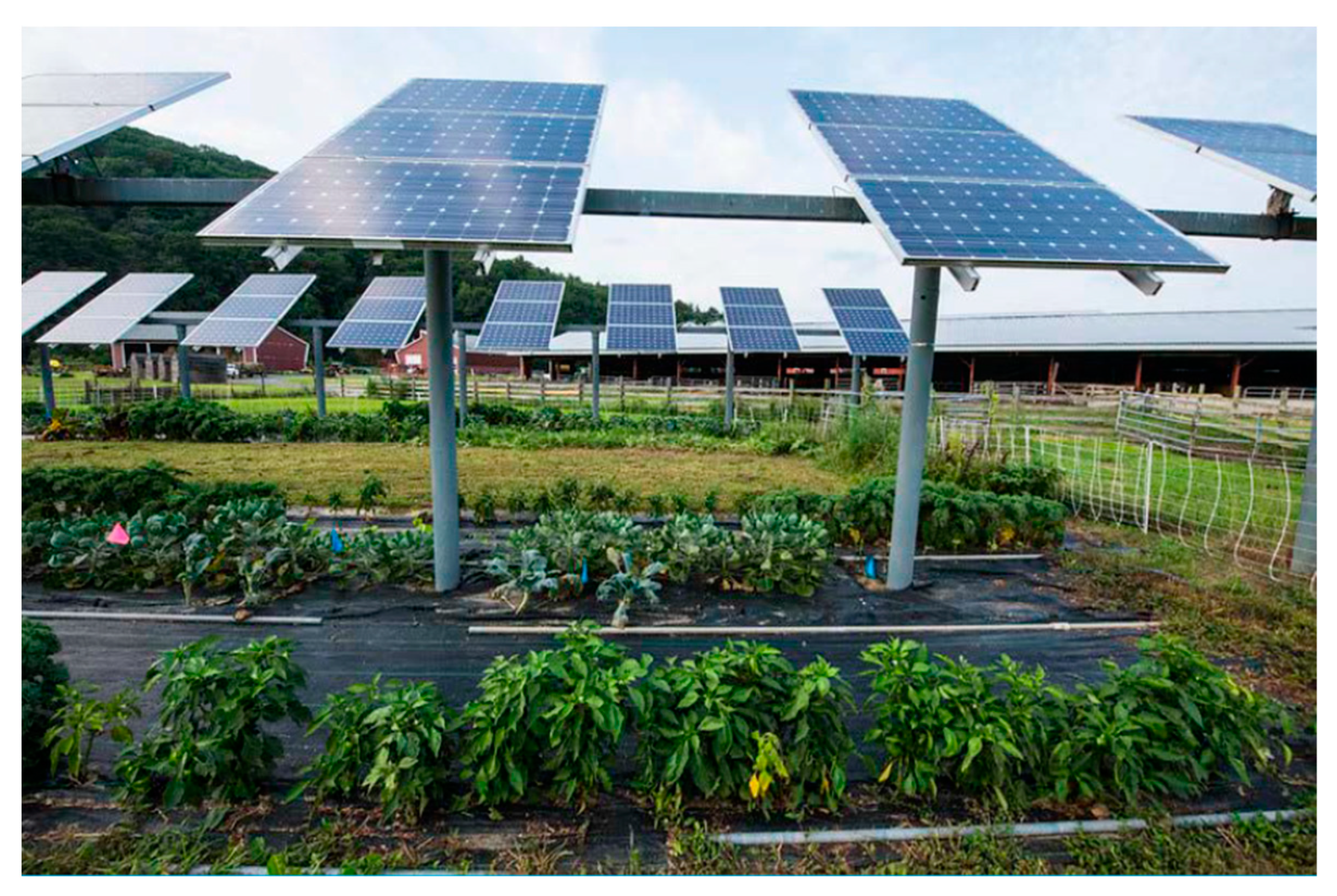

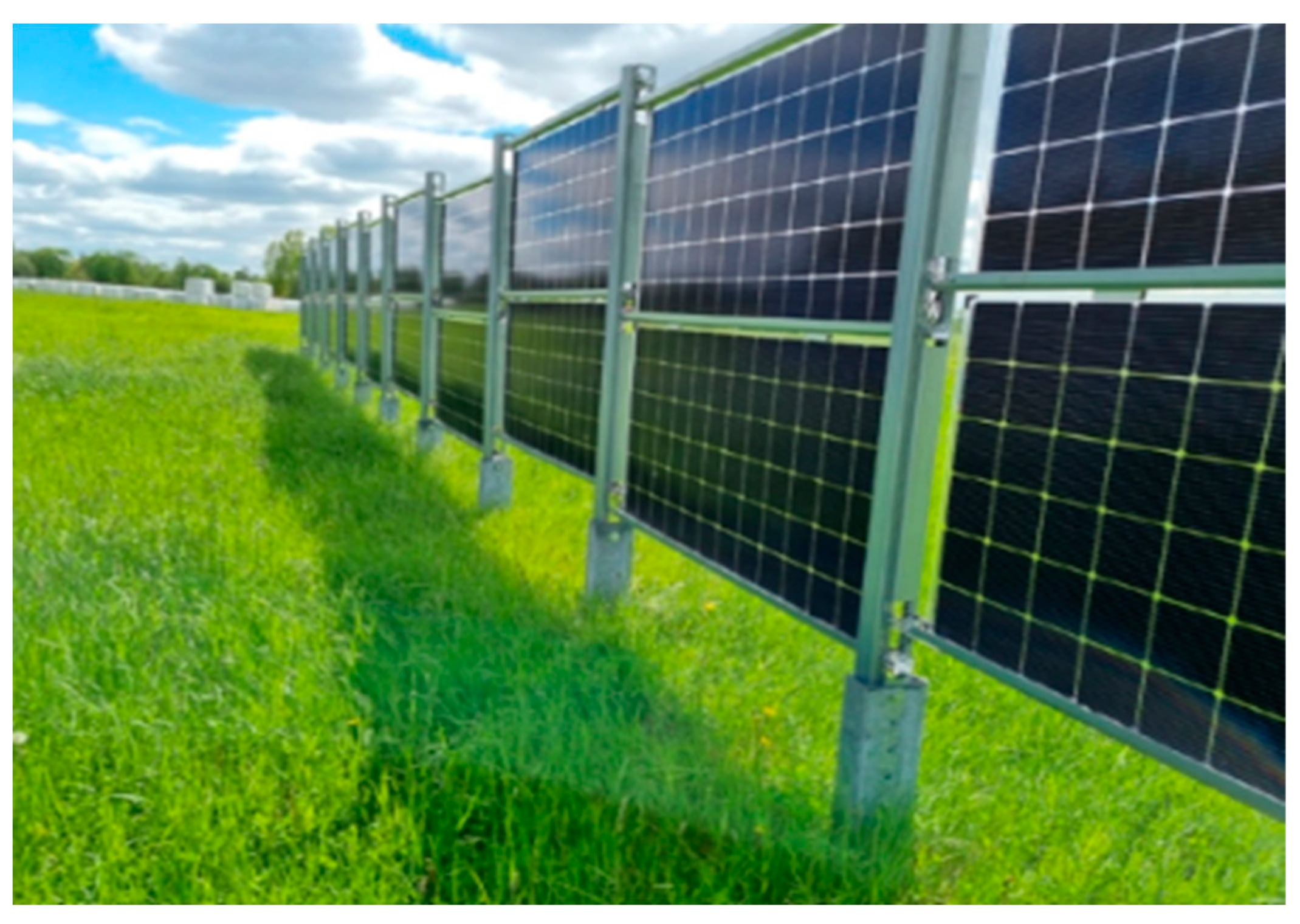
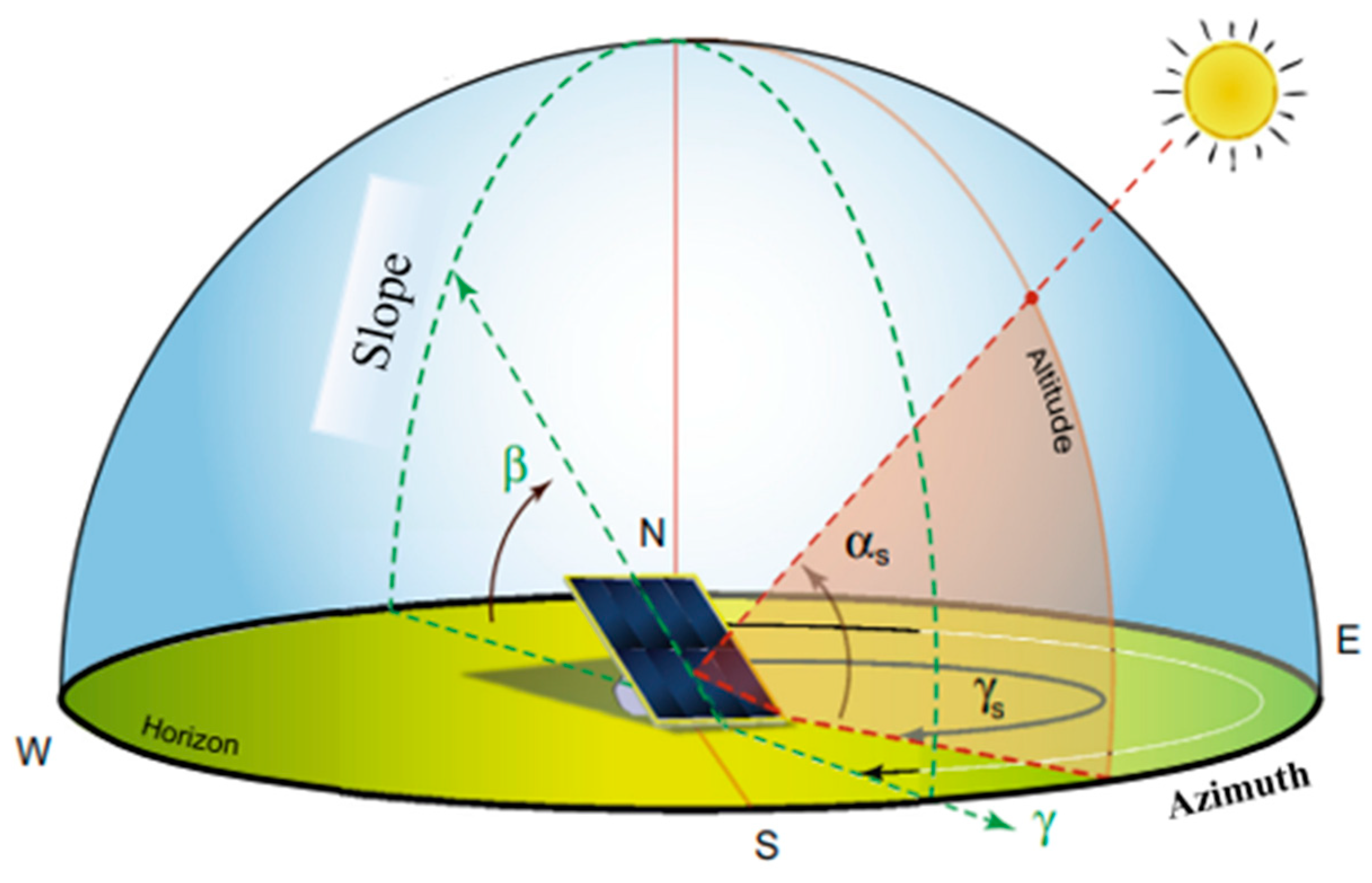

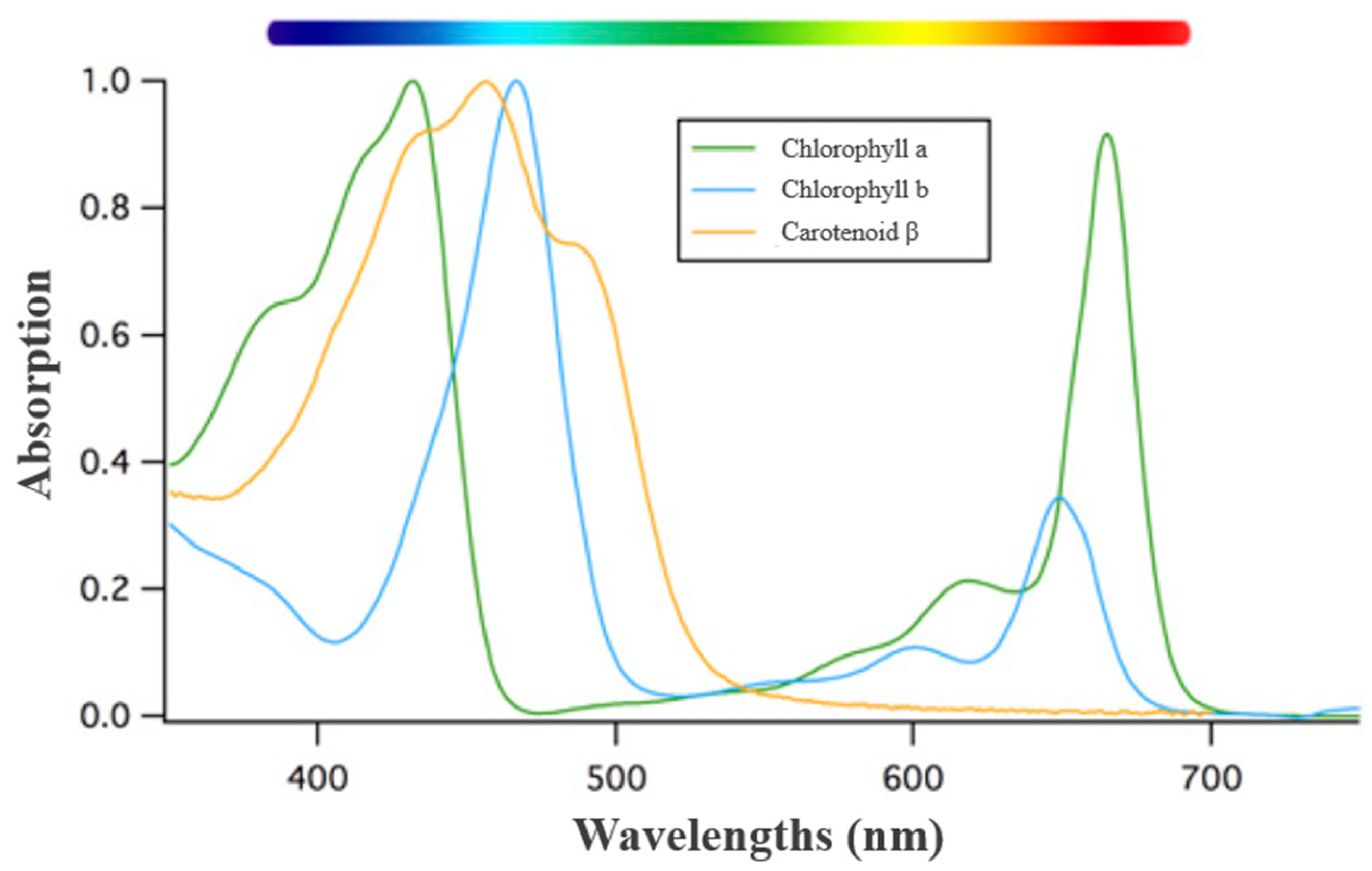
| Type of Installation | Strengths | Weakness |
|---|---|---|
| Inter-row systems |
|
|
| Elevated systems with spacing between rows of panels |
|
|
| Tracking systems |
|
|
| Vertical mounting systems |
|
|
| Crops | Study Area | Height and/or Spacing or Shading Rate | Impact on Culture | Sources |
|---|---|---|---|---|
| Durum wheat | Montpelier, France | Height of 4 m Spacing 1.64 m (distance between the lower side of two consecutive panels) Tilt of 25° |
| [24] |
| Lettuce and cucumber | Montpelier, France | Height of 4 m Tilt of 25° |
| [50] |
| Lettuce | Montpelier, France | Height of 4 m Two spacings: 1.6 m in full density and 3.2 m between rows in half density Tilt of 25° |
| [49] |
| Lettuce | Kansas, USA state | Height of 4 m Two spacings: 6.4 m in half density and 3.2 m between rows in full density |
| [38] |
| Chili and tomato | Tucson, USA | Height of 3.3 m above the soil surface at their lowest point Spacing of 1 m Tilt of 32° |
| [54] |
| Maize | Chiba Prefecture, Japan | Height of 2.7 m Two row spacings: 0.71 m for high-density and 1.67 m for low-density Tilt of 30° |
| [55] |
| Grape | Ongjin-Gun, Republic of Korea | Height of 2 m Tilt of 15° Shading level of 30 of the total roof area |
| [56] |
| Basil and spinach | Italy | - |
| [28] |
| Sesame, mung bean, kidney bean, corn and soybean | Jeollanam-do, South Korea | Height of 5.42 m Shading rates of 32%, 25.6% and 21.3% |
| [48] |
| Oilseed rape, onion, faba bean and forage maize in rotation with potato melon, carrot, onion and dry pea in rotation with tomato | Sevilla, Spain | Height of 5 m Spacing of 9.5 m between suppoted structure Tilt of 27° |
| [58] |
| Celery | Southwest Germany | Row distance: 9.5 m (2.8 times module row width)Height (free space in the direction of the work/top edge): 5.5 m/8 m |
| [59] |
| Red beet, winter wheat, potato and red clover | Southwest Germany | Height of 5 mSpacing of 6.3 mTilt of 20° |
| [125] |
| Rice, onion, garlic, rye, soybean, bean, maize, forage crop | South Korea | Height of 3.3 mSpacing of 1.5 mShading rate of 30% |
| [126] |
| Rice, potato, sesame, and soybean | South Korea | Height between 4 m and 4.5 m |
| [42] |
| Soybean | Monticelli d’Ongina, Italy | Height of 4 to 4.5 mSpacing between rows of trackers of panels of 12 mfour treatments: 27%, 16%, 9% and 18% shading |
| [127] |
| Advantages/Disadvantages | Description | Source |
|---|---|---|
| Advantages on PV panel | Increase energy production due to increased area through the LER | [39,117] |
| Decrease in temperature of solar panels could be achieved by using agricultural moisture, evaporation from agricultural activities, and transpiration from crops which results in the increase in electricity generation | [128] | |
| PV panels in agrivoltaic systems can generate between 3.05% and 3.2% more energy compared to PV installations without cultivated crops | [129] | |
| Decrease in ambient temperature can cause an increase of 1.29–3.33% in the maximum power output of the PV array | [97] | |
| The presence of surface green due to vegetation at the bottom of the panels can results in an increase of 0.25 to 0.4% in the efficiency of the solar panels | [99] | |
| Disadvantages on PV panel | Agrivoltaic can reduce the efficiency of electricity generation or agriculture when taken separately | [39] |
| Decrease in the electricity produced with the reduction in the density of solar PV panels | [38,48,55] |
Disclaimer/Publisher’s Note: The statements, opinions and data contained in all publications are solely those of the individual author(s) and contributor(s) and not of MDPI and/or the editor(s). MDPI and/or the editor(s) disclaim responsibility for any injury to people or property resulting from any ideas, methods, instructions or products referred to in the content. |
© 2023 by the authors. Licensee MDPI, Basel, Switzerland. This article is an open access article distributed under the terms and conditions of the Creative Commons Attribution (CC BY) license (https://creativecommons.org/licenses/by/4.0/).
Share and Cite
Sarr, A.; Soro, Y.M.; Tossa, A.K.; Diop, L. Agrivoltaic, a Synergistic Co-Location of Agricultural and Energy Production in Perpetual Mutation: A Comprehensive Review. Processes 2023, 11, 948. https://doi.org/10.3390/pr11030948
Sarr A, Soro YM, Tossa AK, Diop L. Agrivoltaic, a Synergistic Co-Location of Agricultural and Energy Production in Perpetual Mutation: A Comprehensive Review. Processes. 2023; 11(3):948. https://doi.org/10.3390/pr11030948
Chicago/Turabian StyleSarr, Aminata, Y. M. Soro, Alain K. Tossa, and Lamine Diop. 2023. "Agrivoltaic, a Synergistic Co-Location of Agricultural and Energy Production in Perpetual Mutation: A Comprehensive Review" Processes 11, no. 3: 948. https://doi.org/10.3390/pr11030948
APA StyleSarr, A., Soro, Y. M., Tossa, A. K., & Diop, L. (2023). Agrivoltaic, a Synergistic Co-Location of Agricultural and Energy Production in Perpetual Mutation: A Comprehensive Review. Processes, 11(3), 948. https://doi.org/10.3390/pr11030948





